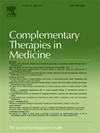奇异果(salvia hispanica. L)对人体测量指标和其他心脏代谢风险因素的影响:系统综述和剂量反应荟萃分析。
IF 3.5
3区 医学
Q1 INTEGRATIVE & COMPLEMENTARY MEDICINE
引用次数: 0
摘要
背景:现有的随机对照试验(RCT)对奇异果功效的研究结果并不一致。尽管以前的荟萃分析总结了这方面的现有研究结果,但一些局限性可能会扭曲研究结果。此外,这些荟萃分析都没有研究奇异果对心脏代谢风险因素(CMRFs)的剂量反应关系。因此,本研究旨在评估食用奇异果对 CMRFs 的影响:方法:通过检索 ISI Web of Science、PubMed 和 Scopus 数据库,纳入截至 2023 年 6 月 2 日的相关 RCT。采用随机效应模型对平均差(MD)和95%置信区间(CI)进行汇总:本系统综述和荟萃分析共纳入了 10 篇文献。结果显示,收缩压(SBP)(MD=-7.87mmHg;95% CI:-12.92 至-2.82;I2 =71.3%,P 异质性 =0.004)、舒张压(MD=-6.33mmHg;95%CI:-7.33至-5.34,I2=0%,P异质性=0.42)和高密度脂蛋白胆固醇(HDL-c)(MD=-4.09mg/dl;95%CI:-6.76至-1.43,I2=12.4%,P异质性=0.33)。然而,奇异果对其他风险因素的影响并不显著。根据剂量-反应分析,每增加10克/天的奇异果摄入量可显著降低SBP(MD=-2.20毫米汞柱;95%CI:-3.75至-0.66,I2=78.9%,P异质性2=0%,P异质性=0.52):结论:食用奇异果可能对降低血压有益。结论:食用奇异果可能对降低血压有益,也会导致高密度脂蛋白-c水平略有下降。由于纳入研究的质量大多较低,因此应谨慎解释研究结果。要进一步了解食用奇异果的剂量依赖效应,还需要进行设计合理、样本量更大、随访时间更长的试验。本文章由计算机程序翻译,如有差异,请以英文原文为准。
Effects of chia (Salvia hispanica. L) on anthropometric measures and other cardiometabolic risk factors: A systematic review and dose-response meta-analysis
Background
Findings of available randomized controlled trials (RCTs) on the effects of chia are inconsistent. Although previous meta-analyses summarized available findings in this regard, some limitations may distort their findings. Moreover, none of these meta-analyses examined the dose-response association of chia on cardiometabolic risk factors (CMRFs). Therefore, the present study aimed to evaluate the effect of chia consumption on CMRFs.
Methods
Relevant RCTs were included by searching the ISI Web of Science, PubMed, and Scopus databases up to June 2, 2023. Mean differences (MD) and 95 % confidence intervals (CI) were pooled using random-effects model.
Results
Ten publications were included in this systematic review and the meta-analysis. The results showed a significant reduction in systolic blood pressure (SBP) (MD = -7.87 mmHg; 95 % CI: − 12.92 to − 2.82; I2 = 71.3 %, P heterogeneity = 0.004), diastolic blood pressure (MD = -6.33 mmHg; 95 %CI: − 7.33 to − 5.34, I2 = 0 %, P heterogeneity = 0.42) and high-density lipoprotein cholesterol (HDL-c) (MD = -4.09 mg/dl; 95 %CI: − 6.76 to − 1.43, I2 = 12.4 %, P heterogeneity = 0.33). However, the effects of chia on the other risk factors were not significant. Based on the dose-response analysis, a 10-g/d increase in chia consumption significantly reduced SBP (MD = -2.20 mmHg; 95 %CI: − 3.75 to − 0.66, I2 = 78.9 %, P heterogeneity < 0.001) and HDL-c (MD = -1.10 mg/dl; 95 %CI: − 1.72 to − 0.49, I2 = 0 %, P heterogeneity = 0.52).
Conclusion
Chia consumption might have a beneficial effect on lowering blood pressure. Chia consumption can also lead to a slight reduction in HDL-c levels. As the quality of the included studies was mostly low, the findings should be interpreted with caution. Well-designed trials with larger sample sizes and longer duration of follow-up are needed to provide additional insight into the dose-dependent effects of chia consumption.
求助全文
通过发布文献求助,成功后即可免费获取论文全文。
去求助
来源期刊

Complementary therapies in medicine
医学-全科医学与补充医学
CiteScore
8.60
自引率
2.80%
发文量
101
审稿时长
112 days
期刊介绍:
Complementary Therapies in Medicine is an international, peer-reviewed journal that has considerable appeal to anyone who seeks objective and critical information on complementary therapies or who wishes to deepen their understanding of these approaches. It will be of particular interest to healthcare practitioners including family practitioners, complementary therapists, nurses, and physiotherapists; to academics including social scientists and CAM researchers; to healthcare managers; and to patients. Complementary Therapies in Medicine aims to publish valid, relevant and rigorous research and serious discussion articles with the main purpose of improving healthcare.
 求助内容:
求助内容: 应助结果提醒方式:
应助结果提醒方式:


